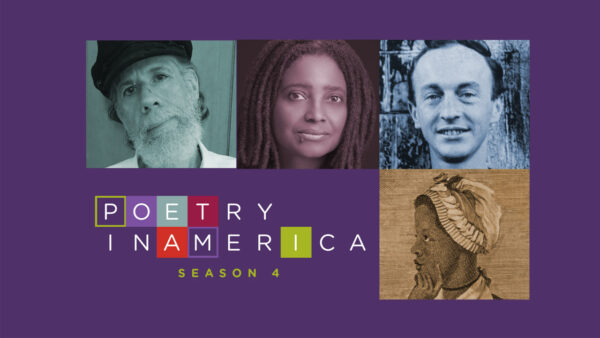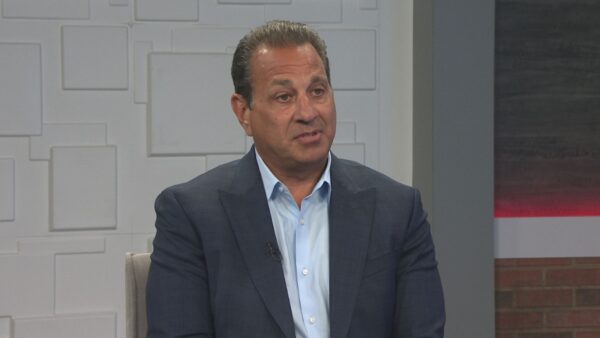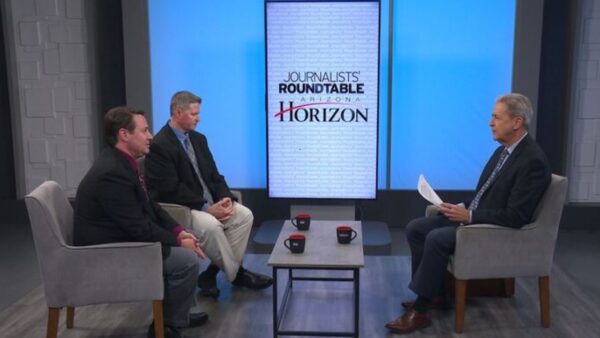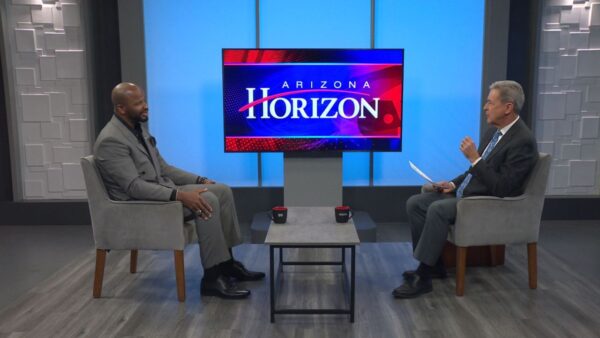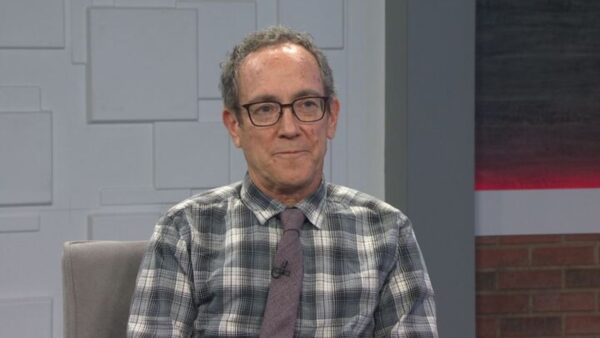An 18-year-old Corona del Sol High School student from Tempe recently took home the top award for electrical and mechanical engineering at the Intel International Science and Engineering Fair in Los Angeles. Sarah Galvin will talk about her award and the project she created to win it. Nathan Newman, a professor at Arizona State University’s Ira A. Fulton School of Engineering, mentored Galvin and will join her on the show.
Ted Simons: An 18-year-old student at Corona Del Sol high school in Tempe recently took home the top award for electrical and mechanical engineering at the Intel international science and engineering fair in Los Angeles. Sarah Galvin is here to talk about her award-winning project. Also joining us is Sarah Galvin's mentor, Nathan Newman, a professor at ASU's Ira A. Fulton school of engineering. Good to have you both here. Thank you for joining us there. The Intel international science and engineering fair, what is this all about?
Sarah Galvin: Well, it's really the top of the top when it comes to the science circuits for the fairs, and it's fascinating because it was really a conglomeration of 1,700 students and it is the best projects in the world coming together so that we can share ideas and interact on more the level of higher intelligence in a way.
Ted Simons: Were you familiar with the fair before you went out there? Was it anything -- anything about the whole process surprising to you?
Sarah Galvin: The Intel I stuff, it has actually been a dream for a long time. Arizona runs its own series of science fairs for students to prequalify to go to the international fair, and within these fairs I've been interacting at various levels, but I always see on the kind of edges, these people usually wearing suits and they're always the ones who win. I decided a long time ago that is where I wanted to be. So this is the first time I was able to realize that.
Ted Simons: World's largest high school science research competition. That's a lot of kids, that's a lot of folks.
Nathan Newman: Absolutely.
Ted Simons: Talk to us more about, again, how the process -- how the engineering fair developed and your part in all of this.
Nathan Newman: Yeah, so my part is actually just -- we have the privilege of doing research as professors and looking for new knowledge. And part of that is to engage graduate students as the traditional one, but one of the things that ASU does so well is excellence and access. So, the high school students that are interested in preparing for the science fair, we open up our labs, we work with them to choose projects, and we have the great honor of getting these bright, excited young students, and we do all we can to help them succeed and it's really up to them to, you know, learn the fundamentals and then move on to do their project and it gives us great joy to see all of them progress and learn, and some of them, like Sarah, have done so well and just do amazing things that we sit back and watch and are very proud.
Ted Simons: Talk to us now about your project. I understand it's an innovative approach to improve spin polarization in thin films for spin transport electronics, what am I talking about?
Sarah Galvin: Yes sir, well that is the title of my project, but taking it down to a level that is very understandable, the practical application.
Ted Simons: Yes
Sarah Galvin: I'm working in a field that was developed very recently, spintronics, and that focuses on utilizing a different way of manipulating the materials to produce a new kind of electronics based more on magnetism then like passing current, so it allows us to make things smaller and faster, more efficient, and then within that category I'm focusing on a specific material to optimize if for use in these applications.
Ted Simons: And now the material, correct me if I am wrong here, magnesium oxide is usually used, you found a different material to use?
Sarah Galvin: Yes. Magnesium oxide is usually used because it actually creates a higher quality seaFAST which is what the title abbreviates to, but I found that using another substrate, another base structure, which is substantially less expensive, actually produces a better value that we're looking for in the application into these electronic devices.
Ted Simons: More efficient and less expensive?
Sarah Galvin: Yes, sir.
Ted Simons: No wonder you won the award. So, when Sarah came to you with this idea or said, hey, here is what I'm thinking, what were you thinking?
Nathan Newman: Oh, I thought it was great. To be honest Sarah had been working in the lab a little bit last year, and so we had been working on this type of electronics, and what we hope it can do eventually is right now computers have memory, and logic in the separate. The devices that Sarah was working on pioneering allows you to make magnetic memory right on chip. So you can have a computer on a chip. We won't need computers that have the separate one. So, when Sarah said she would like to look at a material that is more efficient and choose a substrate that would work better, we made sure the equipment was there, we asked her what the plan was and we let her carry it out. What I usually do is we meet on a regular basis and I ask what did you do, what did you find? What does it mean?
Ted Simons: Right.
Nathan Newman: And then I watch as the project progresses, and it starts with, you know, a seed and it grows. It is real exciting.
Ted Simons: When the project does progress, are you watching every step of the way going, boy, I sure hope this works, and just kind of watching? Because, I mean, it may not work.
Sarah Galvin: Absolutely. That's really what research-based science is. It is very different from my high school classes, for instance, chemistry, where my teacher always knows what the end result of a lab is going to be, because he knows the educational target. But in research-based science, that is really what allows us to expand into the unknown. It's one of the most interesting parts for me personally.
Ted Simons: So why did you go into this particular, was there something about this idea that got your attention? How did you get started in all of this?
Sarah Galvin: I started working with Professor Newman through ASU's SCENE program, which is an educational outreach for high school students such as myself, and his lab deals predominantly with these types of projects within the spintronics applications, and a couple of months ago, he said -- I was just finishing another project. He really said find something that interests you, bring it back to me, and if it is viable, we'll go. So I did a bunch of research and I found this material was particularly interesting to me from a physics standpoint and we decided to run with it.
Ted Simons: Run with it you did. Now I'm assuming occasionally a kid will come to you, and you will say no, would you steer them in a different direction? Obviously with Sarah you didn't, but sometimes do you have to kind of nudge a little bit?
Nathan Newman: You try not to say no too often.
Ted Simons: Sure.
Nathan Newman: Because if you do the experiments and you're always right, you're not doing the right experiments. So you have to try new things. Sometimes I'll explain what the limitations are, why I'm concerned, you know, research is such a great way to learn. That's why research is done at the universities. And so when a student comes and they say this is -- this is new and this is something that I'm going to try, I never say no, but I do say here is the conventional wisdom. Do you want to try it?
Ted Simons: Here is what you need to think about.
Nathan Newman: That's right. And hopefully, you know, we learn something and 99% of the time we learn things, not everything works.
Ted Simons: What are you thinking about as far as taking this particular project into the future, taking your education into the future? What's next for you?
Sarah Galvin: Well, I, first of all, I'm going to be attending ASU in the fall. So I'm going to continue working for Professor Nathan Newman because it has been a fantastic opportunity, and with that said, I would like to continue looking into this, because it is very interesting and my results would indicate something that really needs to be spread to the public. So hopefully we will be publishing on something very similar to this and that way the information will get out so others can expand upon it.
Ted Simons: As far as you expanding though, are there other avenues, other things that interest you that once you get to the university, you're going to think I might nose around over here a little bit?
Sarah Galvin: I think that one of the best parts about ASU is that it is such a large environment, but you can specialize and make it more of a small school experience. So, my work with Professor Newman is fantastic. I really enjoy it. I'm also very interested in government and politics. So maybe I'm going to do a double major or minor in that area. I haven't declared that for my first semester, but it might be second year.
Nathan Newman: I think research scientists are very much needed when it comes to politics. About 30 seconds left here. When you get students coming in, do you have to focus them a little bit or do you want them to spread out and see what they can find?
Nathan Newman: I think it is a combination and it depends. I usually let the students go at their own free will and I watch how it develops. Some students need more step by step guidance and some you stay out of their way. And at the end, we just are there to give opportunities and we hope for success, and so it has been a lot of fun.
Ted Simons: Well very good. Congratulations to you, and congratulations to you. We expect to hear more from you in the future. Thank you so much for being here.
Sarah Galvin: Thank you.
Ted Simons: Thank you both.
Sarah Galvin:Student and Winner, Intel International Science and Engineering Fair; Nathan Newman:Professor, Arizona State University's Ira A. Fulton School of Engineering;



